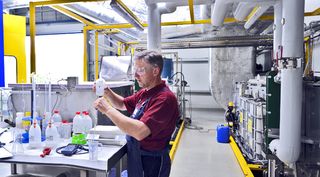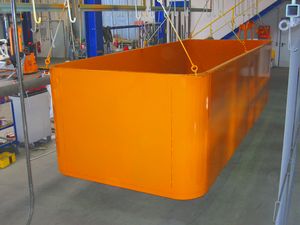Individual pre-treatment for a first-class powder coating

always in close alignment to the specified corrosivity category!
Due to their chemical properties, widely used metals like steel, aluminium and galvanized steel get covered
over time with an oxide layer which is hardly visible on aluminium but occurs as so-called red rust on steel or as white rust on galvanized steel. Fundamentally though, these kinds of oxide layers can conceivably form a poor base for subsequent coating due to their undefined structure and sometimes insufficient adhesion to the sub-surface.
Therefore, the principle is the better the corrosion properties of the coating have to be, the cleaner and more oxide-free the basic material has to be. Even with ideal cleaning of the base material, only limited corrosion properties can be guaranteed depending on the type and thickness of the coating system. The cause of this is the diffusion of water through the coating film to the base material which can then react with the oxide-free surface and form a new oxide layer and can lead to separation and blisters forming!
For the few or non-exposed interior components, mechanical or chemical removal of any oxide present through pickling or abrasive blasting is usually sufficient, abrasive blasting in combination with a passive layer by the familiar iron phosphating. However, if the parts are to come into contact with moisture or corrosion triggering substances, a conversion coating is always undertaken. We can offer the optimum solution for nearly every material and any condition with our fully automated wash system and our sweep and sand blasting systems.
The right pretreatment for every application
Load group I
The parts are only used in the interior area not exposed to moisture or corrosive effects.
Load group II
The parts are exposed to temperature or moisture loads individually or for a short time. The main application area of this stress group is in the interior area.
Required performance of the stress groups:
| stress groups | Salt spray test + *) condensation climate | Boiling test for aluminium | Kesternich test | cross-hatch test | Machu-Test |
|---|---|---|---|---|---|
| I | min. 125 h | 15 min | 3 cycles | Gt 2 | no req. |
| II | min. 250 h | 30 min | 6 cycles | Gt 1 | no req. |
*) Salt spray test: Infiltration of 16 mm² is permitted.
condensation constant climate test: infiltration max. 1 mm, no visible blister formation
What degree of sheen should the coating have?
The sheen is according to a scale of 0 to 100 units, where o is a completely matt surface and 100 is highly glossy. The measurement of the degree of sheen is made according to regulation with an angle of incidence of 60°. The appliance must comply with ISO 2813:1994.
 The sheen categorisation is undertaken as follows:
The sheen categorisation is undertaken as follows:
| category 1 | 0 – 10 fully matt |
| category 2 | 11 – 25 ±5 matt |
| category 3 | 26 – 50 ±5 silk-matt |
| category 4 | 51 – 75 ±5 silk sheen |
| category 5 | > 85 glossy |
| category 6 | > 95 high gloss |
If an order or a drawing specifies the category "matt" the finisher can use units 11 to 25. If no degree of sheen is specified, it is left to the coating company which degree of sheen to select.
Tip: We do not recommend coating pieces with a large area and flat panels with a high degree of sheen. Highly glossy surfaces do not tolerate unevenness. The necessary preparatory work to achieve absolutely flat surfaces causes higher costs. Matt surfaces or structures surfaces tolerate slight unevenness better from a visual point of view.
Rich variety of surface structures
In addition to the requirements of colour and sheen, a range of structures can be created. Along with the familiarhammered effect coarse, medium and smooth structures are possible. As the manufacturers of powder and liquid varnishes offer their own samples which differ from other manufacturers, defining the structure in advance is recommended - generally also to the suppliers of the coating substance.
